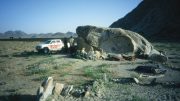All the previously discussed pioneers with streets named after them in Elliot Lake either worked for or were associated with Technical Mine Consultants, Preston East Dome or Consolidated Denison. Dr. Earl Gillanders was the exception, as well he should be, for he was exceptional.
Gillanders was the all-important Rio Tinto Zinc (RTZ) connection. What makes this significant is that, on his way up the ladder as a mining engineer, Gillanders was eventually employed by Eldorado Nuclear as general manager for both the Great Bear and Beaverlodge operations. These mines were essential to the Canadian uranium industry. Gillanders later joined RTZ and worked out of the Toronto office.
Most people are not aware, or don’t remember, that during the Second World War, uranium was the hottest strategic metal in the history of mining because of the emergence of the atomic bomb and its subsequent use as a threat in the Cold War. Until about 1949, it was against the law to prospect, or even explore for, uranium in Canada. However, Eldorado, a Crown corporation, was exempt from this law. This became the ideal fit for Franc Joubin (1911-1997) and Joseph Hirshhorn (1899-1981). Unlike the earlier official executives with Phelps Dodge and New Jersey Zinc, who considered taking control of Rio Algom, Gillanders was different. He had uranium-mining experience, he knew the general Canadian mining scene and the economics of the situation, as well as having an inside track with Eldorado and the federal government.
I first met Gillanders while I was working for the Rix uranium mine, near Beaverlodge, Sask. It was the first publicly traded uranium mine in Canada. Since our ore was eventually processed at the Eldorado mill, we needed their help from time to time. I finally got through the chain of command and ended up on Gillanders’ doorstep. He was pleasant, thoughtful and always helpful.
Some years later Gillanders told me an amusing anecdote while working in the same office at Rio Algom on Richmond Street in Toronto. He said there was an unusually high ratio of women to men at Eldorado’s Beaverlodge operations. Most of these women were single and hired by some other member of his staff for various jobs. Much to his surprise, Gillanders discovered that most of the daytime female employees were also “ladies of the night,” who, no doubt, made 10 times the money of the average miner and probably a lot more than even the general manager.
Gillanders was not in the field during the staking and developing of the Elliot Lake camp, but I got to know and respect the man when I worked at the Rio Algom head office in Toronto.
He had a diverse and interesting mining career. A graduate of the University of British Columbia in geology, Gillanders traveled to Africa, working for the geological survey of South Rhodesia (now Zimbabwe) for three years.
He returned to North America, where he obtained his PhD in geology from Princeton University, and then went back to Africa for two more years. He ventured home during the Second World War and headed north to Timmins, Ont., where he worked in the gold camps. He eventually ended up as chief geologist at the prolific Sigma Gold Mines, controlled by Dome, near Val d’Or Quebec.
While at Sigma, Gillanders realized that his career as chief geologist had reached a standstill. Much to the surprise of the mine’s manager, Gillanders requested to work underground as a miner. In short order, he became a shift boss, then captain, and later, underground superintendent. (All of this basic training, combined with his geological background, probably helped him throughout his distinguished career as a prominent mining executive.) He finished his career as head of Rio Algom’s Canadian operations — a position he probably garnered as a result of what Joubin called his “remarkable technical and administrative skills.”
He was elected as president of the Mining Association of Canada, but, to my knowledge, was not given any awards or significant recognition. Something others might be unaware of is that Gillanders was an original member and vice-chairman of the Elliot Lake Improvement Development Committee.
One might describe Gillanders as a poor man’s Gary Cooper — quiet by nature, but when he spoke it was with authority and efficiency. He was genuinely respected and liked by all who knew him. He was a modest man by nature, but, like a few others, his outstanding biography slipped through the cracks of mining history.
Next week: Franc Joubin.
The author, a professional engineer, resides in Barrie, Ont.



Be the first to comment on "Odds ‘n’ sods: Gillanders – an exceptional pioneer"